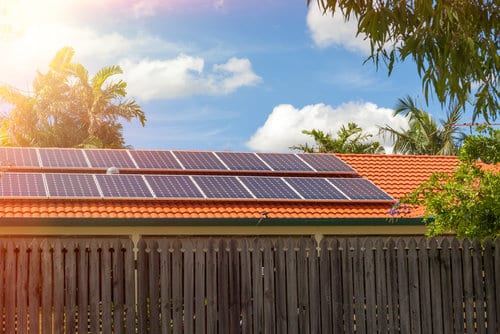
Solar Choice recently wrote about the potential for a battery storage incentive program under the Renewable Energy Target. Here, we take an equally speculative approach in looking at an incentive program for battery storage in Queensland based on (voluntary) Solar Bonus Scheme feed-in tariff buyouts. If you have thoughts or feedback about what is discussed here, we’d love to hear it – either in the comments or via email ([email protected])
Queensland’s Solar Bonus Scheme is now closed to new applicants, but there are still tens of thousands of residential solar system owners who benefit from the generous 44c/kWh rate that the program pays out to recipients. Provided they don’t move house or upgrade their solar system size, these homes will continue continue to receive this incentive until 2028.
This is great for those who are enrolled in the Solar Bonus Scheme, but not everyone is a fan. Some noteworthy opponents include the Queensland Productivity Commission (QPC), who have suggested that the program be brought to an early close to cut the costs associated with it. Although this idea has been dismissed (the same outcome as similar proposals in NSW and WA), Queensland’s regional network company Ergon was at one point contemplating a voluntary buyout program, where Solar Bonus Scheme recipients receive an up-front sum equal to a portion of their total feed-in tariff benefit out to 2028.
But what if the Queensland government were to take slightly different approach, where FiT liabilities were paid out in the form of a battery storage system incentive? Basically, a home benefitting from the Solar Bonus Scheme would be offered a lump sum to put towards a battery storage system; the amount of this sum would be based on their total feed-in tariff liability out to 2028. Forfeiting their FiT would allow those homes who want batteries to get them – at a heavily discounted rate or at virtually no out-of-pocket cost to them. In addition to creating a pathway to home energy independence, they would also potentially be able to avoid tax liability for a windfall payout should they receive cash instead.
Calculating the value of a hypothetical FiT buyout
While the whole idea of such a buyout is still purely speculation, we though that it would be interesting to explore what parameters might be put on this kind of scheme and what the outputs would be. Tweaking these parameters, we can estimate the maximum and minimum amounts that an up-front payment / battery incentive could be.
The main questions regarding payout would revolve around the following variables:
- Solar system size
- Ratio of solar export vs solar self-consumption
- The date of the buyout (i.e. how many years of FiT payments remain?)
- Assumed percentage of the buyout (the government would probably offer a discounted payout of 50-75% total FiT liability)
- Location (and associated solar resource)
- How panel degradation is accounted for
Based on these factors (plus a few others), we’ve put together the below calculator tool to allow anyone to estimate what their FiT payout might be if such a program were implemented. As should be obvious, the tool is not prescriptive or even relevant to any real-life program – we’ve only put it together to stimulate conversation on the topic.
As you can see, the outputs vary dramatically depending on how the parameters are set, with a potential incentive value ranging from as little as about $8,500 to as much as over $42,000 for a 5kW system. A ‘middle of the road’ result would be about $12,000-$15,000 for someone who accepted a buyout sometime next year.
How much battery capacity would a FiT payout buy?
How much battery capacity would that that buy? That also depends. Of the many options available in Australia, lithium-ion and lead-type batteries are the two most popular battery chemistries for home energy storage on the market at the moment (although we certainly shouldn’t discount others like Aquion and RedFlow). The former are a great option for grid-connected systems while the latter are the tried-and-trusted solution for off-grid systems (although they may also be used for on-grid or partial off-grid systems).
The table below provides a quick glance at how battery system installation costs would stack up at a range of price points – from ‘very optimistic’ on the low end to ‘realistic but possibly still a bit pricey’ on the high end.
| Battery type | Price point(per kWh capacity) | 5kWh | 7kWh | 10kWh | 20kWh |
|---|---|---|---|---|---|
| Lithium-ion | @$700 | $3,500 | $4,900 | $7,000 | $14,000 |
| @$1,000 | $5,000 | $7,000 | $10,000 | $20,000 | |
| @$1,200 | $6,000 | $8,400 | $12,000 | $24,000 | |
| @$1,500 | $7,500 | $10,500 | $15,000 | $30,000 | |
| @2,000 | $10,000 | $14,000 | $20,000 | $40,000 | |
| Lead-type | @$300 | $1,500 | $2,100 | $3,000 | $6,000 |
| @$500 | $2,500 | $3,500 | $5,000 | $10,000 | |
| @$700 | $3,500 | $4,900 | $7,000 | $14,000 | |
| @$800 | $4,000 | $5,600 | $8,000 | $16,000 |
For a lithium-ion battery bank fully installed, a retail price of $1,000 per kWh of fully installed capacity (e.g. $7,000 for a 7kWh battery storage system) is fairly optimistic at the time of writing. At around this price, a moderately optimistic FiT buyout for a 5kW solar system (~$15,000) would allow a home to purchase about 13-15kWh battery storage system.
A battery bank of this size – while not being enough to allow a home to go off-grid – is still nothing to sneeze at. For many homes, it would be enough for them to become energy self-sufficient for most days of the year (that is, purchasing no energy from the grid). If the home in question had particularly low daily electricity demand in the first place and decided they wanted to get fully or partially off the grid, they might opt for a lead-based battery solution instead (pending some very serious consultations with a number of solar installers, of course).\
Would cashing your FiT in be worth it?
Even in the best case scenario outlined above, the savings achieved by installing a battery bank may not match up with the value of the FiT over 10-12 years. Conversely, a larger system purchased with a larger buyout may deliver inferior returns to a smaller one. We’ve done some indicative analysis in the table below.
(Importantly, figures in the table do not factor in revenues gained from energy trading on the NEM using approaches like Reposit Power’s GridCredits. Reposit’s technology promises to sweeten the economic case for installing batteries further by allowing homes to benefit from premium peak-time feed-in rates.)
| Buyout scenario: North-facing 5kW solar system in Brisbane, 25kWh consumption per day, 6c/kWh FiT rate, 25c/kWh electricity price, ‘double peak’ usage pattern | |||||
| FiT value @50% export & 90% panel efficiency | Buyout terms | Buyout amount (battery subsidy amount) | Approx battery system size purchasable (@$1,000/kWh) | Rough battery system payback (w/ tariff arbitrage*) | Net Present Value (NPV) @ 6% discount rate |
|
$19,500
|
100% value | $19,500 | 20kWh | 13.7 | -$2,800 |
| 75% value | $14,625 | 15kWh | 11.7 | $1,400 | |
| 50% value | $9,750 | 10kWh | 7 | $5,200 | |
| *Charging batteries with grid at cheap rates, discharging during expensive peak times. Assumed rates: 10c/kWh off-peak, 42c/kWh peak, 18c/kWh shoulder | |||||
The (somewhat unsurprising) general conclusion we can draw is that any FiT buyout / battery storage incentive would probably be of most interest to early adopters, technology enthusiasts and those who despise dealing with electricity retailers. It might also hold a lot of appeal to those who know they’re going to sell their home – the FiT benefit evaporates when a house changes hands, but a battery storage system will continue to deliver benefits, therefore presumably increasing a home’s value.
Another important point to make is that homes should probably be allowed to put money towards expanding their solar arrays as well as installing batteries. In the ‘highly optimistic’ buyout scenarios, where system owners are given full credit or nearly full credit for their FiT upfront, the maximum size of the battery bank that the home could purchase would probably be much too large for their needs – especially if they’re charging the batteries only with solar (no grid charging). Instead of earmarking the payout money only for batteries, the government might opt to make the program flexible enough to allow for additional solar panels as well. This would allow homes to select a system whose balance of battery and solar capacity is tailored to meet their needs.
With these thoughts in mind, those who are interested in exploring the possibilities are encouraged to do the maths either using Solar Choice’s battery sizing & payback estimator tool, or with the NSW Farmers / AgInnovators calculator (which was created for NSW but which is nevertheless useful as an indicative guide.)
We should also not that the absence of this kind of an incentive shouldn’t deter those who are interested in batteries from investigating them! If you’re a home-owner considering a battery storage system, just make sure you do your homework: get opinions & quotes from multiple installers to make sure you’re well informed before making a decision.
This article was first published in One Step Off The Grid, where you can read more stories about people’s experiences with solar, storage, energy efficiency and other technologies, both on and off the grid. To sign up for the weekly newsletter, click here.








